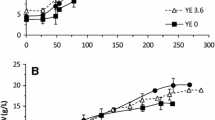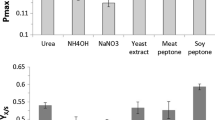Abstract
Worldwide, there is growing interest in achieving a meaningful use of natural resources, as epitomized in this work, which demonstrates the use of saline wastewater (WW) from the demineralization of cheese whey as the main component of a medium for cultivation of spirulina (Limnospira maxima). Based on Zarrouk medium and the fundamental composition of spirulina biomass, a novel cultivation medium for photoautotrophic cultivation of spirulina was developed. The wastewater medium (WWM) consisted of WW supplemented with NaHCO3, urea, K2HPO4, and FeSO4. The suitability of WWM was evaluated by comparison of spirulina growth in laboratory scale tubular or gas-lift photobioreactors in WWM and Zarrouk medium (ZM). The maximum biomass productivity of 0.36 g L−1 day−1 was achieved in WWM, compared with 0.24 g L−1 day−1 in ZM. The cost of WWM was less than 50% of the cost of ZM.





Similar content being viewed by others
Data availability
The datasets generated during and/or analyzed during the current study are available from the corresponding author on reasonable request.
References
Alibaba (2020) Chemicals. https://www.alibaba.com/Chemicals_p8. Accessed 27 December 2020
Cañizares RO, Domínguez AR (1993) Growth of Spirulina maxima on swine waste. Bioresour Technol 45:73–75
Costa JA, Cozza K, Santos L, Magagnin G (2001) Different nitrogen sources and growth responses of Spirulina platensis in microenvironments. World J Microbiol Biotechnol 17:439–442
Danesi EDG, Rangel-Yagui OC, de Carvalho MJC (2011) Growth and content of Spirulina platensis biomass chlorophyll cultivated at different values of light intensity and temperature using different nitrogen sources. Braz J Microbiol 42:362–373
de Wit JN (2001) Lecturer’s Handbook on whey and whey products. European Whey Products Association, Brussels
Depraetere O, Foubert I, Muylaert K (2013) Decolorisation of piggery wastewater to stimulate the production of Arthrospira platensis. Bioresour Technol 148:366–372
Djaghoubi A, Bouhoun MD, Said SH, Saggaï A, Sobti S, Aissa BH (2015) Growth and nitrogen removal efficiency as protein content of Spirulina from tertiary municipal wastewater in Ouargla (Algerian Bas-Sahara). Energy Procedia 74:1402–1409
Fakhri M, Antika PW, Ekawati AW (2020) Growth, pigment and protein production of Spirulina platensis under different Ca(NO3)2 concentrations. J Aquacult Fish Health 9:38–47
Food and Agriculture Organization of the United Nations, FAO (2020) Overview of global dairy market developments 2019. Dairy Market Review. http://www.fao.org/3/ca8341en/CA8341EN.pdf
Fox RD (1996) Spirulina: production & potential. Édisud, Avignon. 234 p
Ghaly MN, Rushton D, Arab F (2007) Potential environmental and health impacts of high land application of cheese whey. Am J Agric Biol Sci 2:106–117
Ghobrini D, Potočár T, Smolová J, Krausová G, Yakoub-Bougdal S, Brányik T (2020) Heterotrophic cultivation of Chlorella vulgaris using saline waste water from the demineralization of cheese whey. Biotechnol Lett 42:209–217
Gonzáles-Siso MI (1996) The biotechnological utilization of cheese whey: a review. Bioresour Technol 57:1–11
Gomez C, Guzman-Carrasco A, Lafarga T, Acien-Fernandez FG (2020) Optimization of a new culture medium for the large-scale production of protein-rich Arthrospira platensis (Oscillatoriales, Cyanophyceae). J Phycol 57:636–644
Gorgich M, Passos MLC, Mata TM, Martins AA, Saraiva ML, Caetano NS (2020) Enhancing extracion and purification of phycocyanin from Arthrospira sp. with lower energy consumption. Energy Rep 6:312–318
Gouveia L, Batista AP, Sousa I, Raymundo A, Bandarra NM (2008) Microalgae in novel food products. In: Papadopoulos KN (ed) Food Chemistry Research Developments. Nova Science Publishers, New York, pp 1–37
Gouveia L, Oliveira AC (2009) Microalgae as a raw material for biofuels production. J Ind Microbiol Biotechnol 36:269–274
Griffiths MJ, Garcin C, van Hille RP, Harrison STL (2011) Interference by pigment in the estimation of microalgal biomass concentration by optical density. J Microbiol Methods 85:119–123
Humhal T, Kastanek P, Jezkova Z, Cadkova A, Kohoutkova J, Brányik T (2016) Use of saline waste water from demineralization of cheese whey for cultivation of Schizochytrium limacinum PA-968 and Japonochytrium marinum AN-4. Bioproc Biosyst Eng 40:395–402
Khandual S, Sanchez EOL, Andrews HE, de la Rosa JDP (2021) Phycocyanin content and nutritional profile of Arthrospira platensis from Mexico: efficient extraction process and stability evaluation of phycocyanin. BMC Chem 15:1–13
Kosikowski FV (1968) Nutritional beverages from acid whey powder. J Dairy Sci 51:1299–1301
Kunsel T, Sumant O (2020) Spirulina market. https://www.alliedmarketresearch.com/spirulina-market. Accessed 27 December 2020
Laborator Monitoring (2021) Wastewater analysis. https://www.moni.cz/en/services/wastewater-analysis. Accessed 26 October 2021
Lafarga T, Fernandez-Sevilla JM, Gonzalez-Lopez C, Acien-Fernandez FG (2020) Spirulina for the food and functional food industries. Food Res Int 137:109356
Lichtenthaler H, Wellburn A (1983) Determinations of total carotenoids and chlorophylls a and b of leaf extracts in different solvents. Biochem Soc Trans 11:591–592
Markou G, Chatzipavlidis I, Georgakakis D (2012) Cultivation of Arthrospira (Spirulina) platensis in olive-oil mill wastewater treated with sodium hypochlorite. Bioresour Technol 112:234–241
Markou G, Vandamme D, Muylaert K (2014) Microalgal and cyanobacterial cultivation: The supply of nutrients. Water Res 65:186–202
Marquez FJ, Sasaki K, Kakizono T, Nishio N, Nagai S (1993) Growth characteristics of Spirulina platensis in mixotrophic and heterotophic conditions. J Ferment Bioeng 76:408–410
Morocho-Jácome AL, Mascioli GF, Sato S, Monteiro de Carvalho JC (2016) Evaluation of physicochemical treatment conditions for the reuse of a spent growth medium in Arthrospira platensis cultivation. Algal Res 13:159–166
Olguín EJ, Galicia S, Angulo-Guerrero O, Hernández E (2001) The effect of low light flux and nitrogen deficiency on the chemical composition of Spirulina sp. (Arthrospira) grown on digested pig waste. Bioresour Technol 77:19–24
Park WS, Kim HJ, Li M, Lim DH, Kim J, Kwak SS, Kang CM, Ferruzzi MG, Ahn MJ (2018) Two Classes of Pigments, Carotenoids and C-Phycocyanin, in Spirulina Powder and Their Antioxidant Activities. Molecules 23(8):2065. https://doi.org/10.3390/molecules23082065
Pereira MIB, Chagas BME, Sassi R, Medeiros GF, Aguiar EM, Borba LHF, Silva EPE, Neto JCA, Rangel AHN (2019) Mixotrophic cultivation of Spirulina platensis in dairy wastewater: Effects on the production of biomass, biochemical composition and antioxidant capacity. PLoS ONE 14:1–17
Phang SM, Miah MS, Yeoh BG, Hashim MA (2000) Spirulina cultivation in digested sago starch factory wastewater. J Appl Phycol 12:395–400
Raoof B, Kaushik BD, Prasanna R (2006) Formulation of a low-cost medium for mass production of Spirulina. Biomass Bioenerg 30:537–542
Research Institute of Brewing and Malting, RIBM (2021) Analytical laboratories. https://beerresearch.cz/en/analyses-and-tests/analytical-laboratories/. Accessed 26 October 2021
Rizal M, Yeasmin F, Hossain M, Akter T, Rahman MM (2017) Replacement of sodium nitrate in Kosaric medium with urea for culture of Spirulina platensis. Int J Fish Aquat Stud 5:403–408
Ryan M, Walsh G (2016) The biotechnological potential of whey. Rev Environ Sci Biotechnol 15:479–498
Sachdeva N, Giambarresi G, Poughon L, Cabrera JC, Leroy B, Lasseur C, Dussap CG, Wattiez R (2018) Assessment of transient effects of alternative nitrogen sources in continuous cultures of Arthrospira sp. using proteomic, modeling and biochemical tools. Bioresour Technol 267:492–501
Shi JQ, Wu ZX, Song LR (2012) Physiological and molecular responses to calcium supplementation in Microcystis aeruginosa (Cyanobacteria). N Z J Mar Freshwater Res 47:51–61
Sienkiewicz T, Riedel CL (1990) Whey and whey utilization: possibility for utilization in agriculture and food stuff. Th. Mann, Germany, 215
State Veterinary Institute, SVI (2021) Food and feedstuff analysis. https://www.svupraha.cz/en/food-and-feedstuff-analysis. Accessed 26 October 2021
Strathmann H (1986) Electrodialysis. In: Bungay PM, Lonsdale HK, de Pinho MN (eds) Synthetic Membranes: Science, Engineering and Applications. D. Reidel Publishing, Dordrecht, pp 197–223
Vieira DCM, Matsudo MC, Sato S, Converti A, de Carvalho JCM (2012) Simultaneous use of urea and potassium nitrate for Arthrospira (Spirulina) platensis cultivation. Biotechnol J 7:649–655
Vonshak A (ed) (2002) Spirulina platensis (Arthrospira): Physiology, Cell-biology and Biotechnology. Taylor and Francis, London
Zarrouk C (1966) Contribution à l’étuded’unecyanophycée. Influence de Divers Facteurs Physiques et Chimiques Sur la Croissance et la Photosynthèse de Spirulina maxima. Thesis, Université de Paris, France
Funding
This work was supported by the Ministry of Agriculture of the Czech Republic through project QK1910300 and institutional support MZE-RO1918.
Author information
Authors and Affiliations
Corresponding author
Ethics declarations
Conflict of interest
The authors declare no competing interests.
Additional information
Publisher's Note
Springer Nature remains neutral with regard to jurisdictional claims in published maps and institutional affiliations.
Rights and permissions
About this article
Cite this article
Lucakova, S., Branyikova, I., Branyik, T. et al. Wastewater from the demineralization of cheese whey for cost-efficient cultivation of spirulina. J Appl Phycol 34, 89–99 (2022). https://doi.org/10.1007/s10811-021-02644-4
Received:
Revised:
Accepted:
Published:
Issue Date:
DOI: https://doi.org/10.1007/s10811-021-02644-4




